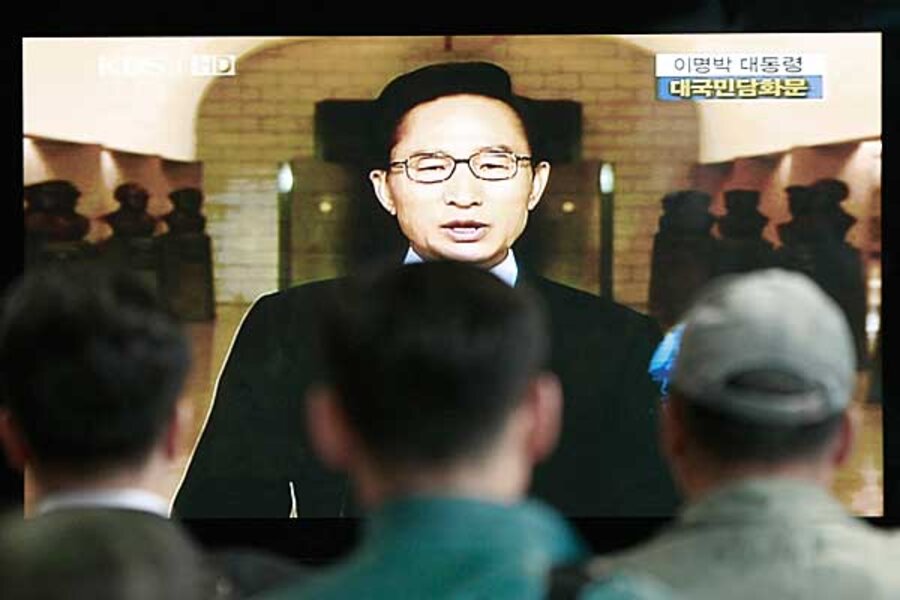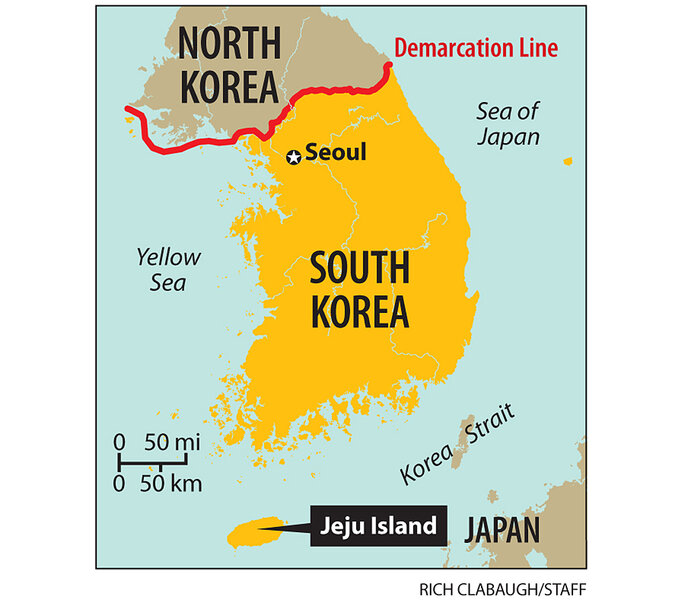How will North Korea respond to South Korea's threats?
Loading...
| Seoul, South Korea
South Korea President Lee Myung-bak issued a strongly worded declaration Monday of retaliatory measures against North Korea for torpedoing the navy ship Cheonan. The question now: How will North Korea respond?
Analysts predict fresh North Korean military challenges in the waters around South Korea – and more rounds of naval warfare. Some are concerned that North Korea may conduct a third nuclear weapons test or test-fire more missiles. In any case, threats are flying on the Korean Peninsula in what may be a new period of danger – and diplomacy.
North Korea has already threatened to fire on South Korean loudspeakers if they resume propaganda broadcasts from their side of the Demilitarized Zone (DMZ) that has divided the Korean peninsula since the end of the Korean War.
Mr. Lee, vowing to prevent any repetition of North Korean “brutality,” suspended North-South trade and an agreement that gave North Korean vessels the right to go through South Korean waters around the southern end of the peninsula. Those measures, plus a diplomatic campaign to get the UN Security Council to impose sanctions, raised the specter of a wide range of North Korean responses.
North 'will test' South
“A typical menu would include another nuclear test and missile test-firing,” says Kim Sung-han, professor of international relations at Korea University. But he predicts that North Korea first “will test the will of South Korea by sending vessels into South Korean waters.”
North Korea may begin, he says, by seeing if South Korea will really ban North Korean ships from sailing through the straits between Jeju Island, off South Korea’s southern coast, and the southern tip of South Korea. The ban tacks on two or three additional days of travel to North Korean vessels making the long trip to and from ports on the North’s east and west coasts.
“Then they will try to cross the Northern Limit Line in the Yellow Sea,” says Professor Kim, citing the danger of more skirmishes near where a North Korean submarine on March 26 fired a torpedo at the 1,200-ton corvette Cheonan, sinking it and killing 46 of the 104 sailors on board, according to the findings of an international investigation.
President Lee, vowing that North Korea would “pay a price corresponding to its provocative acts,” said South Korea “from now on will not tolerate any provocative act by the North and will maintain the principle of proactive deterrence.”
The inference was that South Korea would intensify patrols, including anti-submarine exercises, in the Yellow Sea along the Northern Limit Line below which South Korea bans North Korean vessels.
“If our territorial waters, airspace, or territory are violated,” said Lee, “we will immediately exercise our right of self-defense.”
Points of attack
Some analysts say any military confrontation could escalate beyond the level of naval engagements. “If we have another attack, they will try to destroy the attacking submarine,” says Kim Tae-woo at the Korea Institute for Defense Analyses. “Then North Korea may threaten the safety of our commercial air flights” – and he fears may stage a surprise attack on land.
North Korea signaled just that possibility with a threat to fire on the DMZ mega-loudspeakers used by South Korea to shout propaganda into the North before ceasing all such broadcasts during the decade of the Sunshine policy of reconciliation. Pyongyang’s Korean Central News Agency quoted an anonymous commander as declaring that North Korean forces would “start the firing of direct sighting shots to destroy” the facilities for broadcasting propaganda.
The commander promised escalating attacks “to eliminate the root cause of the provocations,” according to the North Korean report, “if the group of traitors challenges the just reaction” of the North.
Rodong Sinmun, the Workers’ Party newspaper, repeating North Korea’s denial of anything to do with the sinking of the Cheonan, denounced South Korea’s claim as “an intolerable, grave provocation.”
South and North Korea delineated their positions in the midst of a flurry of diplomacy in which Secretary of State Hillary Clinton, in China, sought to persuade the Chinese to act forcefully to cool down tensions. China has been reluctant to accept South Korea’s version of the attack while offering tacit support of North Korea, which it keeps on life support with food, funding, and military assistance.
What will China and Hillary Clinton do?
China is not expected to go along with strong UN Security Council sanctions, but Ms. Clinton said she was working “to avoid an escalation of belligerence and provocation.” She is expected to offer unstinting support for South Korea’s position when she meets President Lee and other top South Korean officials here Wednesday.
“From this time on the capacity of the president is tested,” says Paik Hak Son, North Korea analyst at the Sejong Institute here. “We are dealing with political and security implications, China and North Korea on one side and the U.S., Japan and South Korea on the other side. It will be a serious and difficult task.”
The question now is how much more China will be willing to do to make up for South Korean economic pressure. North Korea exports to South Korea, including seafood, sand, minerals and clothing items, exceed its imports from the South by about $200 million.
Another issue is whether North Korea will shut South Korean factories in the Kaesong Economic Complex just above the line with South Korea about 40 miles north of Seoul. North Korea makes about $50 million a year from the zone, including pay for about 42,000 workers in the zone that the workers never see. With the cutoff of trade and South Korean investment in the North, the zone remains the only real point of inter-Korean relations.
Analysts disagree, however, on the extent to which North and South Korea will be willing to risk more clashes – or why North Korea staged the attack on the Cheonan. South Korea has a gross domestic product many times that of North Korea but faces massive losses if North Korea ever makes good on threats to turn Seoul into "a sea of fire."
“I think we are going to see something big,” says Brian Myers, a professor at Dongseo University in Pusan and author of “The Cleanest Race,” a critical look at North Korea. “The simple fact of Lee Myung-bak’s standing up to the North Koreans is in itself a threat to them.”
But Andrei Lankov, a professor at Kookmin University in Seoul and author of a number of books on North Korea, adopts a more sanguine view. Lee “looked bellicose and tough without doing anything,” he says. “He knew perfectly well that no revenge is possible. It will scare away investors. The best policy is to wait until emotions calm down.”
Related:






